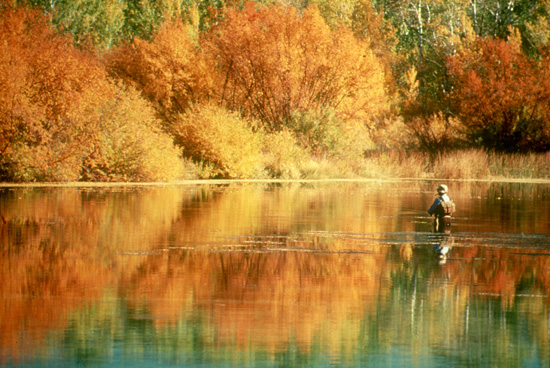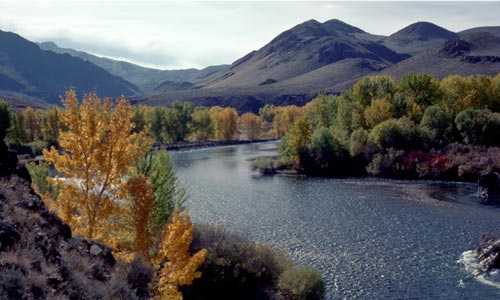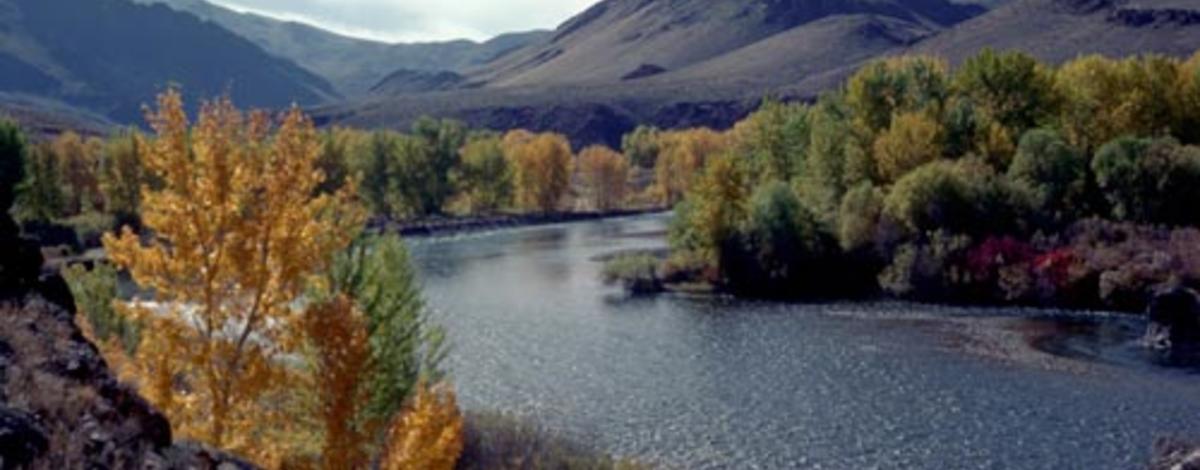For many Idahoans, feeling cool morning air and seeing hints of red and gold in the forest means it’s time to lace up the boots and grab a gun or bow for hunting season, but don’t overlook fall fishing. That cool weather means many fish are re-energized after their summer slumbers and ready to eat like bears fattening up for winter.

Fall fishing may be overshadowed by Idaho’s hunting season, but it’s not an either/or proposition. Idaho is famous for its “cast and blast” opportunities, and if you’re not a hunter, it’s also a great time to experience your favorite fishing spots when there are likely fewer people there.
Most rivers are also running low and more easily accessible than during high water, and anglers shouldn’t overlook lakes and reservoirs, either. While some are near their lowest water level of the year and may be sporting extra vegetation, cooler water means the fish become more active, and they’ve probably gained a few inches or ounces since spring.
Fish and Game's fish stocking crews also return to many local ponds and other nearby waters that become too warm for trout during summer. It’s a great opportunity to squeeze in some fishing time without traveling far from home.

Here are some suggestions from Fish and Game’s fisheries managers and information staff around the state about some good fall fishing spots you might want to check out. This is just a sampler of what's available in the fall for anglers. To find more, visit the Idaho Fishing Planner.
Panhandle Region
Coeur d’Alene Lake: There is excellent kokanee fishing to be had here in the fall when mature kokanee start to stage near tributaries on the north side of the lake prior to spawning. Kokanee tend to be the biggest during fall, averaging somewhere in the 13- to 15-inch range, and anglers have a last chance to harvest the fish before they start changing colors (and get less tasty). Kokanee fishing is already hot on Coeur d’Alene Lake, and that should continue through early October. During the fall, the best angling typically occurs on the northern end of the lake near Wolf Lodge Bay.
St. Joe River: Along its 140-mile stretch, “the Joe” offers a little bit of everything. At its upper reaches, the St. Joe River is more like a high-mountain stream. This is where the Joe gets its reputation as one of the premier blue-ribbon native trout waters in the West. Here, the St. Joe River runs wild through conifer forest; downriver near its mouth, it slows, widens, and meanders through cottonwoods and agricultural land as it approaches Coeur d’Alene lake. The upper stretches of the Joe are clear, cold, gorgeous and full of native trout that have been in Idaho since before the ice age. Westslope cutthroat trout and bull trout provide unique catch and release fishing opportunities for anglers, and some of the best fishing on the Joe happens in September. Anglers on the upper St. Joe can also run into (and harvest) mountain whitefish. On the lower flatwater reach, smallmouth bass, northern pike, and yellow perch provide warmwater fishing opportunity.
Clearwater Region
Clearwater River: While there is a bag-limit reduction and size restrictions on the Clearwater River in what looks to be a lean year for fall steelhead, fall Chinook fishing in the Clearwater River system was recently expanded by the Idaho Fish and Game Commission. The biggest change in opportunity came on the mainstem Clearwater. New areas were opened up to Chinook fishing from Memorial Bridge in Lewiston upstream to the confluence of the Middle Fork and South Fork Clearwater rivers. Anglers can keep up to six adult fall Chinook salmon per day, only one of which may have an adipose fin, and an unlimited number of jacks, which are smaller than 24 inches.
Upper Clearwater tributaries: Fall offers some of the best fishing of the year for native westslope cutthroat. These waters provide not only great opportunities for fly anglers, but also pleasant weather and some breathtaking scenery. The North Fork Clearwater River and Kelly Creek are two storied cutthroat waters that anglers should consider. If they time it right, fall anglers will be treated to a full palette of autumn colors, both on the trees and in the river as kokanee make their way upstream from Dworshak Reservoir to spawn. Many other waters in the Clearwater River system are worth visiting in the fall, including the Lochsa and Selway rivers. Be sure to check the 2019-21 Idaho Fishing regulations before you head out, as each of the waters mentioned here have special rules in place.
Southwest Region
South Fork Boise River: As the most popular fall river fishery in Southwest Idaho for quality wild rainbow trout and mountain whitefish, this one stands out as obvious. But things on the South Fork will be a little different this year. Typically, by the end of September, flows have dropped to 600 cfs., which is conducive to wading and greatly increases the popularity of the river. Because of a stuck clamshell gate in Arrowrock Reservoir, the U.S. Bureau of Reclamation is having to keep flows high to avoid dropping the Arrowrock pool, and likely won’t be able to fix the stuck gate until after irrigation season in mid-October. So, while the South Fork Boise will still be a great fall fishery, it will mainly be a float fishery with limited wading until flows come down later than usual.
Snake River: While it won’t be long before the Snake River becomes a hotspot for waterfowl hunters, the fall is still a great time to catch bass and catfish in the river. Fall is often overlooked, but it can be a great time to catch bass, especially early in the season. As temperatures drop and days begin to shorten, bass can become aggressive feeders heading into the winter.
Magic Valley Region
Big Wood River: Ketchum, Hemingway, golden aspens and rainbow trout. What more could you possibly ask for a memorable fall fishing trip? It’s easy to romanticize the Big Wood knowing Papa Hemingway waded those same waters and probably fished the same riffles, but even without the romance, there’s still good fishing in the Big Wood. It’s brimming with trout, and there’s a good chance they will be eating insects off the surface at some point during the day.
Mormon Reservoir: A lot has been written about this reservoir. It's been a bit mysterious in the last couple years, but nearly 38,000 trout went into it in May and June. Some of those fish got caught during summer, but plenty are left, and this reservoir has shown it’s capable of growing big trout, so check it out.
Southeast Region
Blackfoot River: This could be a sleeper this fall. Fish and Game is hearing some good reports from anglers about cutthroat fishing in the Blackfoot, which in recent years has been pretty tough. Fish and Game has done pelican management to take some of the predation off spawning fish, and it appears to be paying off with more cutthroat in the river. Anglers can find good fishing access at Fish and Game’s 2,400-acre Blackfoot River Wildlife Management Area in the upper reaches. Downstream shore access is limited due to private land, but anglers can still find some access points for wade fishing.
Snake River: Eastern Idaho has a wealth of blue-ribbon trout streams, which occasionally means the great rivers overshadow the good ones. This may be the case with the Snake River downstream from Idaho Falls to American Falls Reservoir. The river has lots of big, and in some cases, even huge rainbow and brown trout. This section of river is most commonly fished from boats, which is probably the preferred method, but as irrigation demand declines and river levels recede during fall, it opens more opportunities for banks access and wading. While standard trout tackle will do fine for most fish, remember there are trout in the 10-pound range lurking, so you might break out the heavier tackle.
Upper Snake Region
Henrys Lake: This lake needs no introduction to most Idaho anglers, but in case you’re unaware, it’s filled with trophy-sized trout, and September and October are prime fishing months. Beware this area is known to get early snowstorms, so watch the weather, but catch rates are already good and expected to get better as fall progresses. You can catch cutthroat trout, cutthroat/rainbow hybrids known as "cuttbows," and the largest brook trout you will find anywhere in Idaho. Both the weight record and catch-and-release record for brook trout were set there. Henrys Lake State Park is located on the lake shore as a camping option, and there’s lodging nearby that will keep you out of the weather.
Upper Big Lost River Basin: With Eastern Idaho’s embarrassment of riches for trout anglers, some rivers get overshadowed, but don’t let yourself take the name of the Big Lost, as in “lost in the shuffle” too literally. The upper reaches of this river system, which includes Wildhorse Creek and the East Fork of the Big Lost, have recently been stocked with catchable trout. This area also provides a scenic fishing opportunity that’s close to great hunting areas. These waters are accessible, but are also remote enough that you can find solitude. Also, the upper stretch of Wildhorse Creek has lots of wild trout fishing opportunities
Salmon Region
Williams Lake: Like many lakes, this one tends to get a case of summer doldrums when the water warms, then it rebounds in the fall as it cools. Anglers can find plenty of rainbows in the 12- to-16-inch range that are readily caught on bait, lure and flies. Float tubes and boats provide anglers access throughout the lake, and while recommended, they are not required to find good fishing. Good bank angling and easy angler access can be found on the northwest side of the lake near the recently improved public boat dock.
Upper Salmon River: This covers a lot of water, and you may want to as well. The Upper Salmon can produce some good trout fishing, but the fish tend to be very migratory, so you will want to move around to find them. There are rainbows, cutthroats and bull trout, and possibly an early arriving steelhead as fall progresses. This tends to be an uncrowded, yet very accessible river because the highway runs right alongside it for dozens of miles, so it's easily accessible for floaters, bank anglers and waders.

